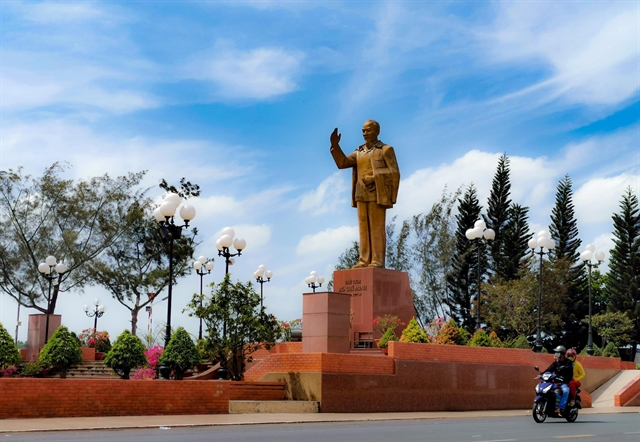[ad_1]
By Thanh Liêm
A statue of President Hồ Chí Minh waving his hand with a warm smile on his face on the Ninh Kiều wharf in the southern city of Cần Thơ, has for a long time been a symbol of the city, which is dubbed the capital of the western region by the Hậu River.

A significant detail of the statue is that the sun always shines on the face of the beloved President throughout the day.
Huỳnh Văn Hoài is one of the veteran officials of the local culture sector, who was assigned to find a suitable place for the statue in 1976.
Hoài was born in 1933 in Tân Phú Thạnh Village, in today’s Cái Răng District, Cần Thơ City.
He used to work as a journalist, an editor at the Radio The Voice of Việt Nam (VOV) since 1967 and then a diplomat overseas.
Now he cannot move due to poor health.
In an interview with Vietnam News Agency, he said his parents had passed away when he was young.
At 12, he was assigned to work as a courier for Việt Minh (League for Independence in Việt Nam) in the locality.
He was injured and caught by the French in a battle in 1952, when he joined in a fight against the French’s trucks travelling along Đông Dương Road (today’’s National Highway 1).
He was given a life sentence by the French regime’s court in Cần Thơ and imprisoned in Cần Thơ, Sài Gòn and Hải Phòng.
After the Geneva Agreement in 1954, he was listed among exchanged prisoners in Sầm Sơn, the central province of Thanh Hóa.
When released, he was sent to study at the Hà Nội General University and then worked for VOV.
In 1970, thanks to his fluency in various foreign languages including Russian and French, Hoài was assigned to work as a cultural attaché at the Vietnamese Embassy in the Soviet Union and then in China.
“After the national reunification in 1975, I expressed my willingness to return home to work and my chief agreed,” he said.
He then worked at the Cần Thơ Foreign Affairs department until his retirement.
Choosing a place
In early 1976, Hoài and some other senior staff in the local culture sector, including painter Phạm Song, who graduated from the famed Indochine Arts College (now University of Fine Arts) in Hà Nội, were assigned to design and choose a proper place to erect a statue of President Hồ Chí Minh.

“The decision to build a statue of President Hồ was made by local authorities according to the aspirations of people in Cần Thơ and the whole Mekong River region,” he said.
“This was a challenging but noble task for us at that time,” he said.
He said the design was not difficult at all as at that time the team had various models to choose from. The more difficult thing was where to put the statue so that all locals could see and pay visit to the beloved President easily.
The team first chose a place in front of the city’s People’s Committee office on today’s Hòa Bình Road.
But the former authorities did not agree as the area was not solemn enough for the statue.
“I thought it over and over,” he said. “Finally I saw Ninh Kiều Wharf was the most suitable place,” he recalled. “As the place looks over water, where boats and ships gather, a central traffic hub of the Mekong Delta region.”
The proposal was supported by the authorities, he said.
“But their demand was that sunlight shine on the face of the statue throughout the day,” he said.
Though he was surprised, he agreed with the demand.
Every day, from early morning to late in the afternoon, Hoài borrowed a boat to travel to the middle of the river. Sometimes he visited a fishing village opposite Ninh Kiều Wharf to observe the direction of the sun.
He did the same every day for several weeks before he could define the proper place for the statue and the direction that the statue should face.
The statue was built in concrete with steel inside, which was inaugurated on September 2, 1976.
The statue was renovated in 2009, to celebrate the 1,000th anniversary of Thăng Long – Hà Nội.
The renovated work measures 7.2m in height, with a base 3.6m in height. It weighs nearly 13 tonnes cast of copper by sculptor Đinh Quang An from the Central Fine Arts Company, who drafted the model and made it in Hà Nội.
The statue features President Hồ standing high above immense water. One of his hands waves to the people. The monument has hosted various important public activities of the city.
“I think this is the most convenient place for an ordinary person like me to pay tribute to Uncle Hồ,” said Phùng Ngọc Thanh, a local retiree.

“The place is also a significant place for tourists to take photos when visiting Cần Thơ. It’s like a check-in place for everyone.” VNS
[ad_2]
Source link
